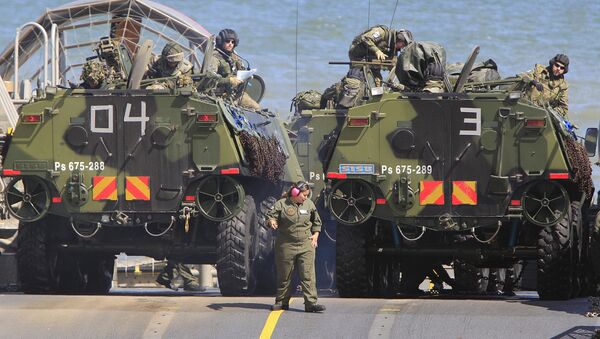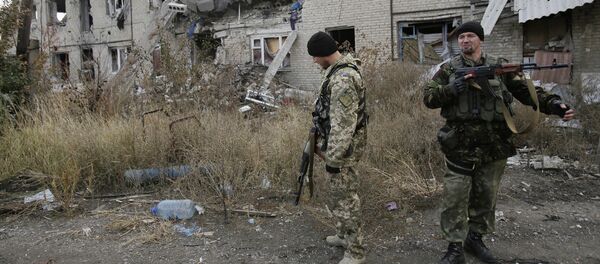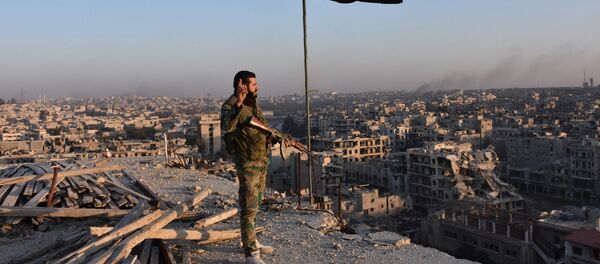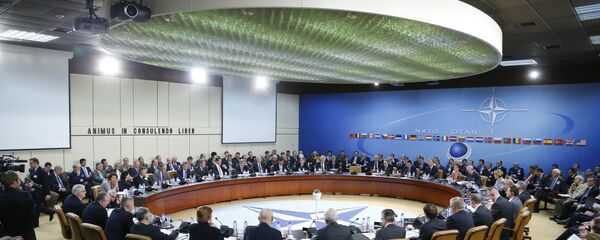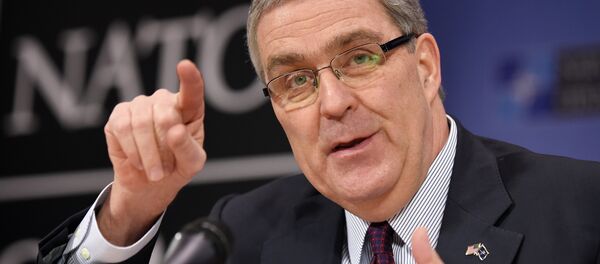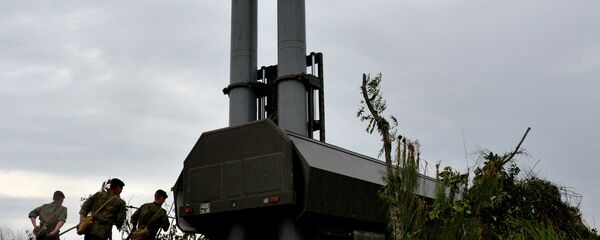MOSCOW (Sputnik) — At the moment, NATO ensures the defense of the Baltic states through its Readiness Action Plan (RAP), which has been implemented since 2014, largely in response to what the alliance perceived as Moscow’s aggression in Ukraine, and comprises various exercises and other activities close to the NATO’s eastern borders.
RAP stipulates tripling NATO Response Force (NRF), which can fulfill operational and educational roles. The Very High Readiness Joint Task Force (VJTF) was created within NRF to handle the situations, which require extremely fast reaction. RAP assurance measures include surveillance flights and maritime patrol aircraft flights over NATO’s eastern flank.
The plan also calls for the establishment of NATO Force Integration Units (NFIUs) in Central and Eastern Europe, of which six, in Bulgaria, Estonia, Latvia, Lithuania, Poland and Romania are already operational and two more, in Hungary and Slovakia, are expected to reach full capabilities in 2017.
While NATO members staunchly refuse to recognize Crimea's decision to reunite with Russia and the peace process to solve the conflict in eastern Ukraine seems to have reached an impasse, the military alliance continues to eschew collaboration with Russia and prefers to treat it as an enemy.
Moscow has repeatedly called for the political solution to the conflict between Kiev and pro-independence militia in eastern Ukraine, with Russian Ambassador to NATO Alexander Grushko recently urging the alliance to "exert pressure on the Kiev authorities to urge them to move from the practical sabotage of the political process to real steps – granting a special status to Donbass, holding a constitutional reform and local elections, adoption of an amnesty law".
Grushko also stressed that if NATO wanted a productive dialogue with Moscow, it had to relinquish its plans to contain Russia and stop building up its defenses in Eastern Europe.
Warsaw Summit Targets Moscow
Ahead of the summit, the Russian Foreign Ministry explained the rearmament of the Russian Army as a reaction to NATO's activities.
"A proportionate response is taking place to the increasing military activities of NATO, which is moving its infrastructure toward Russia's borders with obvious persistence," ministry spokeswoman Maria Zakharova told reporters on July 7.
NATO Secretary General Jens Stoltenberg said at the opening of the summit that the alliance would deploy four multinational battalions in Estonia, Latvia, Lithuania and Poland. Stoltenberg thus confirmed his June 13 promise to deploy about 4,000 troops in the four Eastern Europe countries. NATO members also agreed to boost their presence in the Black Sea, one of Russia’s key zones of interest.
US President Barack Obama said that NATO would not cooperate with Russia in the usual format until Moscow fulfilled its Minsk obligations on Ukrainian settlement. He named Russia, which "has violated the sovereignty and territorial integrity of an independent European nation — Ukraine — and engaged in provocative behavior toward NATO allies" as one of the challenges the alliance was facing.
Obama pledged that the United States would spearhead enhanced NATO presence in Poland to increase commitment to security of its Eastern European ally.
“We now have a continuous presence of US troops in Poland with our aviation detachment at Lask Air Base [and] we continuously rotate personnel and aircraft into Poland,” Obama said.
The Russian Foreign Ministry reacted to the outcome of the summit by saying it was looking closely at the decisions, which had been made, and which, according to the ministry's spokeswoman, showed "that the Alliance focuses on containing a non-existent threat from the East."
"Long-term negative consequences and risks posed to the entire Euro-Atlantic security system, which have emerged as a result of deliberate actions by Washington and Brussels directed at changing the given balance of power, including the accelerated implementation of US/NATO's missile defense plans in Europe, are still being consciously ignored," Zakharova said.
At the Warsaw summit, Stoltenberg summarized the alliance’s two-pronged approach to the relationship with Moscow as a combination of strong defense and, at the same time, readiness for cooperation.
The dual approach could also be seen in press releases issued at the end of the summit. Russia’s actions were branded as "aggressive" and "a source of regional instability," but the alliance expressed willingness to talk to Russia as long as its foreign policy was deemed non-threatening.
Troops and Tech for Europe
The buildup of the NATO presence and defense capabilities in the Eastern Europe is concentrated on the three Baltic States and Poland, with each receiving a roughly 1,000-men strong multinational battalion starting in 2017. This reinforcement is only the latest addition to the continuous bulking up of the military strength.
On December 14, Polish Defense Minister Antoni Macierewicz said that the United States would speed up the deployment of its troops to Poland, Romania and the Baltic countries. A US Armored Brigade Combat Team comprised of about 4,000 soldiers will begin its mission in Poland by the end of January 2017, while the multinational battalion promised by NATO will arrive in April. The ship with the US brigade’s equipment will dock at the German port of Bremenhaven and the hardware will then be quickly sent out to the destinations in Poland, the Baltic countries and Romania, to test the speed of the delivery.
Estonia’s Defense Minister Margus Tsahkna called this decision "a very important signal," and seen in the context of NATO’s aim to counter Russia through beefing up its presence on its borders, the signal might be intended for Moscow.
NATO is gradually amassing and diversifying its military technology in the Baltic countries. A group of six minesweeping warships arrived in Lithuania in November, while Abrams Main Battle Tanks and Bradley Fighting Vehicles from the US Army’s 1st Armored Brigade were sent to the three Baltic countries in June as a gesture of support from the US Army.
In January, Lithuanian Defense Minister Juozas Olekas shared his vision for Lithuania as a US logistics center, ready to expand infrastructure if it was needed to accommodate US military.
The leadership of the four countries receiving additional military aid welcomed it as a way to protect themselves from what they believe to be Russian land-grabbing ambitions.
On July 3, ahead of the Warsaw summit, Lithuanian President Dalia Grybauskaite explained, in an interview to the Financial Times newspaper, the necessity of NATO presence in the Baltic countries as a precaution against the Russians doing "whatever they want."
Grybauskaite also praised Berlin’s involvement, as Germany was set to lead the battalion deployed in Lithuania.
"This is, for us, very symbolic: it means that Germany starts to understand its responsibility for European security," the Lithuanian president said, as quoted in the newspaper.
Estonia shares Lithuania’s apprehension of Russia and thinks little of the possible reset of US-Russian relationship.
"We here in Estonia are rather skeptical that this [reset] could end in a success," Estonian Foreign Minister Sven Mikser told Politico magazine in December.
Russia, in its turn, is also worried about missile build-up close to its borders.
"We consider Washington and Brussels' reluctance to adjust its missile defense plans symptomatic, despite reaching agreements to resolve the situation surrounding the Iranian nuclear program," Deputy Foreign Minister Sergey Ryabkov said in late September.
Grushko expressed concern over NATO's insistence on justifying its actions by the purported Russian threat. According to Grushko, this was evident in countering alleged cyberattacks and "hybrid" operations as well as in propaganda efforts.
"We are certainly concerned about this because such cooperation will inevitably generate new attempts to whip up the myth on the absolute need to defend themselves against Russia," the diplomat stressed.
However, some of the leaders of NATO countries are not enthusiastic about the arms race. In June, Bulgarian Prime Minister Boyko Borissov rebuffed Romanian suggestion to increase NATO presence in the Black Sea, stating that he would prefer the sea to remain touristic rather than militarized territory.
Ships in the Black Sea
On October 26, Stoltenberg said the NATO would finalize details of its enhanced presence in the Black Sea at the defense ministerial meeting expected to take place in February 2017.
NATO chief added that Canada, Germany, Netherlands, Poland, the United States and Turkey, the only country among the six that has an actual stake at the Black Sea, expressed readiness to join this initiative.
Stoltenberg’s announcement came on the next day after the statement of US Permanent Representative to NATO Douglas Lute, who said NATO would "bolster" its presence in Romania, one of the Black Sea countries, by sending a multinational brigade.
On December 7, US Navy Staff Director Vice Adm. James Foggo told Sputnik that the US ships’ mission in the Black Sea could be extended depending on situation, which tallied well with the US Secretary of the Navy Ray Mabus September mention of the US Navy’s worldwide commitment.
"From the Northern Passage to the Straits of Magellan, from the Mediterranean to the Black Sea, from the Gulf of Oman to the Bay of Bengal, and throughout the Pacific, the US 5 Navy will be present, as we have been for seven decades," Mabus said at the 2016 International Seapower Symposium, in a speech that echoed his June statement to the reporters that the US Navy had been in the Black Sea for 70 years and would keep up its presence.
US ships patrol the Black Sea as part of the operation Atlantic Resolve, which, according to the US Department of Defense, allows Washington to help its allies ensure peace and stability in Europe "in light of the Russian intervention in Ukraine."
Russian Foreign Ministry’s Director of the Department for Nonproliferation and Arms Control Mikhail Ulyanov stated in July that Russia does not see non-regional NATO vessels in the Black Sea as a valid security promotion measure, but has to take it into account in its military planning.
Russian Foreign Minister Sergey Lavrov reiterated in December that Russia disapproved of the involvement of non-regional forces in the decision-making process on the matters of security in the Black Sea.
The minister also called the idea to create a NATO permanent naval task force in the Black Sea a provocation.
The head of the Russian Foreign Ministry's European Cooperation Department was similarly opposed to the idea of the expansion of NATO's presence in the region.
"[Russia] will have to respond if such permanent unit with the presence of the NATO non-regional member states is created in the Black Sea," Andrei Kelin told Sputnik in December.
This idea, floated by Romania and Ukraine, would force the nations that do not have natural access to the Black Sea to rotate the ships they deploy as part of the permanent mission, as under the 1936 Montreux Convention, non-Black Sea state warships may stay in the Black Sea no longer than 21 days and their number may not exceed nine at the time.
Not Quite a Circle of Friends
NATO, one of whose main aims since its creation was countering the Soviet Union, has added 12 members since the dissolution of its onetime greatest threat and rival.
The organization itself explains that the world has grown even more dangerous since the end of the Cold War, citing violence in the Middle East and North Africa in the South and "assertive" Russia in the East as examples of modern dangers.
Bosnia and Herzegovina, Georgia, Macedonia and Montenegro are among prospective NATO members, with all four at the different stages of their accession process.
Montenegro seems closer to the goal than other NATO candidates. On December 14, Montenegro Defense Minister Predrag Boskovic said his country was likely to join NATO by spring 2017. According to Boskovic, the decision to join would be put to vote at the largely pro-alliance parliament, where it was likely to be passed.
The Montenegrin public opinion on the membership of NATO, however, is not unanimously favorable. In July, 46.1 percent of the population supported NATO membership, 38.9 percent were against it, and 15 percent were undecided, according to CDM local news outlet, which cited Damar research agency.
Montenegro’s membership also depends on the US Senate’s vote, which is needed for the United States to ratify the new member’s accession. On December 6, the Senate Foreign Affairs Committee approved the Balkan state’s bid for the membership, but the Senate still has to vote on that, and its decision may, in turn, depend on whether the vote happens under current administration or next year, when Donald Trump, famously skeptical of NATO's expediency for the United States, assumes office.
In early December, Russian Foreign Minister Lavrov said Montenegro was "dragged" into the alliance, seemingly, in attempt to have it join the bloc before the outgoing US President left office.
The three other candidates appear to face more significant obstacles to joining.
Macedonia’s accession to NATO was blocked in 2008 by Greece, with whom it is embroiled in a bitter naming dispute.
Bosnia and Herzegovina would have to overcome the division between the two largely autonomous entities the country is made up of. The Republika Srpska with its Serbian majority might be less inclined to join the bloc than the Federation of Bosnia and Herzegovina, especially if joining meant taking a stand against Russia, a long-time ally of the Serbs.
Georgia is determined to join NATO and maintains close contact with the bloc, but has to meet a number of requirements first, including the implementation of various reforms.
On November 10-20, NATO-Georgia drills that involved more than 250 troops took place at the Joint Training and Evaluation Center (JTEC) near the Georgian capital of Tbilisi, with the Russian Foreign Ministry expressing disapproval of the event as a threat to regional security.
Georgian bid for NATO membership is seen in Russia as a security concern as the two countries share a border. The situation is further complicated by the breakaway republics of South Ossetia and Abkhazia, both recognized by Russia as independent countries, but claimed by Georgia as part of its territory.
On November 29, NATO and Moldova agreed to set up a NATO Liaison Office in the Moldovan capital of Chisinau. Stoltenberg emphasized that the office was meant for political rather than military cooperation. Moldova has currently no plans to join the alliance.
While NATO says on its website that it is not "encircling" Russia, citing Russia's size as the reason why this would be impossible, the alliance is reinforcing protection on its eastern borders, which cannot but worry Moscow.
Russian President Vladimir Putin questioned NATO's process of decision making. According to the president, new NATO members could be swayed by the United States into deployment of missile defense and new bases.
"We must therefore take countermeasures… I do not always understand the logic of our partners," Putin said in Oliver Stone's documentary "Ukraine on Fire."
Hope for Dialogue
All hope is not lost for the reset of Russia-NATO relationship, considering the statements made by the bloc’s secretary general and representatives of several member states.
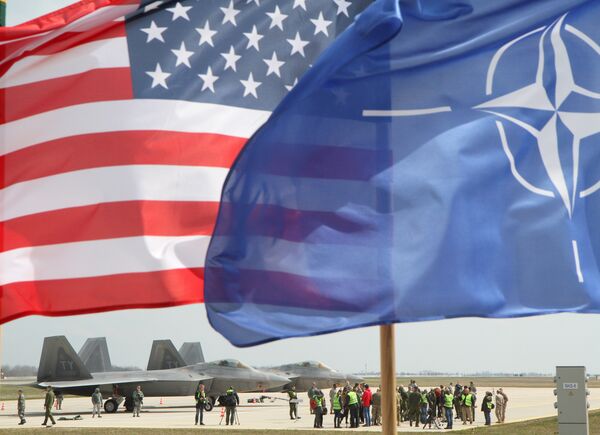
Speaking at a press conference at the Warsaw Summit, Stoltenberg stressed that there was no "imminent threat" to the alliance from the East. NATO chief added that the build-up of the alliance’s presence in the East was partly in response to the possible threats from the Middle East.
The Warsaw declaration on Transatlantic Security stated that the alliance remained open to the dialogue with Russia and would like to continue building a "constructive relationship."
In December, Spanish Foreign Minister Alfonso Dastis spoke out in favor of the dialogue between Russia and NATO and stressed its importance for the resolution of the conflict in Ukraine and ensuring global stability, while Bulgarian President-elect Rumen Radev said that his country’s membership in NATO did not translate into treating Russia as enemy.
Russia has attempted to bridge the gap by promising in August to provide foreign partners with more details about unscheduled drills, which was supposed to reduce tension.
Russian Deputy Defense Minister Anatoly Antonov indicated that Russia was interested in resuming participation in military programs with NATO and in the exchange of information that could help counter terrorist threat.
As the most recent gesture of goodwill, Russia has pledged to invite NATO countries to participate in the International Army Games in 2017.
However, the Russian side remains wary of NATO's plans and attitude. According to Russia's envoy to NATO, the alliance seems disinclined to let go of the perception of Russia as a threat.
"So far, NATO continues to carry out the course that has been identified by decisions in Wales and Warsaw. Its point is to return NATO to the center of Euro-Atlantic security using the so-called Russian threat. For now there is no indication that NATO countries will recant," Grushko told RIA Novosti on November 29.
While Grushko later said that he was hoping for a sincere dialogue with NATO at the bilateral meeting in December, Chief of the Russian Armed Forces General Staff, Army General Valery Gerasimov showed little optimism about the situation.
"The dialogue between the Russian Federation and NATO is frozen, military contacts minimized, the confidence between the alliance and Russia is at the lowest level since the end of the Cold War," Gerasimov said on December 15.
Ahead of the latest NATO-Russia Council, held on December 19, US Permanent Representative to NATO Douglas Lute said that he did not believe Russia was planning to attack NATO, but the alliance had a responsibility to reassure its members, especially those, who, like Estonia, border Russia.
This sentiment was reminiscent of the statement the US President made in August, addressing US disabled veterans.
"In the face of Russian aggression, we’re not going to turn our back to our allies in Europe. We’re going to stay united in NATO, which is the world’s strongest alliance," Obama said, as quoted by the Guardian.
Following the council, Stoltenberg reaffirmed NATO's commitment to keeping the channels of communication open. However, the continuous implementation of the plans which openly admit countering Russia as their goal is probably not likely to speed up the reconciliation process.
Grushko described the recent meeting as "long and comprehensive," but added that he pointed out to the NATO representatives that active collaboration and joining efforts against security concerns that worry both sides would be impossible if the alliance pursued its confrontational policy.
